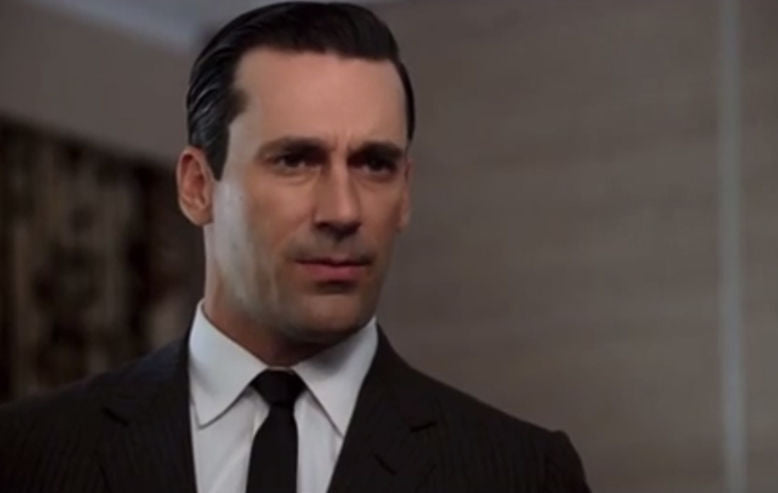I’m going to get vulnerable with you: I feel like I’m taking Mad Men’s inevitable end harder than everybody else. After each episode in the final season, I found myself staring into space, quietly singing “What’ll I do / with only dreams of you / that won’t come true / what’ll I do?”
I will miss the milieu of Mad Men as much as its characters. So, as a coping mechanism, I plan to watch these movies, which roughly chronicle the period in which Mad Men takes place and deal with similar people, places and social issues. If you are hurting as much as I am, I urge you to do the same!
Warning: This post contains minor spoilers about the movies described, but not about Mad Men.
The Man in the Gray Flannel Suit
(Nunnally Johnson, 1956)
Many have noted similarities between Don Draper and WWII veteran Tom Rath (played by Gregory Peck). Tom leaves his wife and three children in Connecticut every day to work as a rising public relations executive in Manhattan. On the train, he remembers his time stationed in Rome, and the relationship he had with a woman there. Like Don, Tom has difficulty finding work-life balance, and struggles to reconcile his experiences in the war with his seemingly idealistic post-war life.A Face in the Crowd
(Elia Kazan, 1957)
This prescient film shows how New York’s media industry can turn a drunken drifter into a beloved television icon and, finally, a powerful and dangerous political figure. Andy Griffith kills it as Larry ‘Lonesome’ Rhodes, who is discovered by a radio reporter in prison and quickly becomes America’s favorite radio and TV star. Although he seems to the world like an all-American country boy who adores his fans, behind the scenes, he is a conniving, contemptuous Machiavelli-type, who knows very well that he can make millions of people follow him everywhere if he manipulates them in the right way.Bigger Than Life
(Nicholas Ray, 1956)
No movie had ever captured the horrors of suburbia like this, and no movie has since. James Mason plays Ed Avery, a loving schoolteacher, husband, and father. He struggles to pay the bills by moonlighting as a cab driver (if you thought that inexcusable pay for school teachers was a recent problem, this movie will prove you wrong). To help him fend off exhaustion, his doctor prescribes speed (with a more scientific name). As the drugs make Ed increasingly abusive, his wife puts her and her son’s life in danger in order to keep up appearances. The movie is a terrifying portrait about how the false expectations of suburbia can ruin lives. Nicholas Ray portrays the Averys' magazine-ad-perfect home as a prison whose shellacked, seemingly indestructible surfaces contribute to the downfall of all who live there.The Sweet Smell of Success
(Alexander Mackendrick, 1957)
Burt Lancaster gives a knockout performance as J.J. Hunsecker, a powerful, influential, and evil Broadway gossip columnist (said to be based on Walter Winchell). He cons sleazy press agent Sidney Falco (a terrific Tony Curtis) into breaking up his sister’s relationship with a jazz musician. The film’s dialogue crackles, and its plot twists keep you enraptured as sordid secrets get revealed. However, I love the film most for its gorgeously shot depiction of New York’s entertainment scene in the late 1950s. Mad Men did not lie. It really was that glamorous, and that wicked.
The Best of Everything
(Jean Negulesco, 1959)
Mad Men’s creator, Matthew Weiner, has cited Rona Jaffe’s bestselling novel and its film adaptation as inspiration for the series. In the first season of Mad Men, Don reads Betty’s copy of the book while in bed with her. “It’s different from the movie,” she says. “It’s dirtier,” he replies. Don’s not wrong—you absolutely must read the book, too. But the movie is brimming with delicious Mad Men-esque style. Hope Lange plays Caroline Bender, an ambitious recent college graduate working her way up at a Madison Avenue publishing company (she and Peggy Olson would probably have a thing or two to talk about). The movie chronicles her love affair with an alcoholic novelist, her friendships with several other working girls, and her battles with editor Amanda Farrow. Joan Crawford kills it as Farrow, spouting all sorts of awesome bitchy dialogue. When Caroline asks if she should type a letter that Amanda has commanded her to write, she responds: “No Miss Bender. Beat it out on a native drum.”The Apartment
(Billy Wilder, 1960)
Possibly the most depressing romantic comedy ever. C.C. Baxter (Jack Lemmon), a cute but nebbishy administrative assistant at a Manhattan insurance company, tries to rise in the ranks by letting his supervisors sleep with their mistresses in his apartment. He finally gets a promotion, only to find that his new boss, Sheldrake (coolly cruel Fred MacMurray), wants to take advantage of his bordello as well. Baxter’s situation becomes more emotionally complex when he realizes that his boss’ mistress is also his crush, Fran (Shirley MacLaine), the office elevator girl. When Sheldrake dumps Fran to go back to his wife and family in the suburbs, she attempts suicide in Baxter’s apartment. Will love bloom from these dire circumstances?Valley of the Dolls
(Mark Robson, 1967)
These days, people tend to mock this glossy, trashy, hit film adaptation of Jacqueline Susann’s blockbuster novel, which follows a group of women as they achieve stardom in New York and self-destruct in Los Angeles. Sure, Patty Duke is over the top as Neely O’ Hara, “who was such a nice kid, until someone put her name in lights and turned her into a lush” (according to the trailer). But she’s also moving. Yes, the hair and outfits are insane, but no less insane and phenomenal than top fashions actually were at the time. Even though it has its camp value, the movie powerfully comments on the intense, unreasonable pressures that the entertainment industry places on women who hope to succeed. Megan Draper, bi-coastal aspiring actress, would have fit in well with the women played by Duke, Barbara Parkins, and Sharon Tate. In fact, Megan’sValley of the Dolls-esque looks, including a T-shirt famously worn by Tate as part of a photo spread, fueled conspiracy theorists’ rumors that, like Tate, the character would eventually be killed by a Manson-esque cult.Rosemary’s Baby
(Roman Polanski, 1968)
Rumors about Megan’s fate were further fueled by the fact that references toRosemary’s Baby, directed by Sharon Tate’s husband, were all over season six. Don and Megan went to see the movie, and ran into Peggy Olson there! She later pitched a commercial based on its infamous last scene. Sally is reading the book when an ominous lady breaks into Don’s apartment and tries to steal things. It makes sense that Rosemary’s Baby looms over Mad Men. In addition to perfectly encapsulating the look and feel of late 1960s Manhattan (Apartment décor makeovers! Vidal Sassoon hair-dos! Hip parties! Glamorous intellectual senior citizen/Satanists! The Dakota!), it also represents the same American cultural crisis that Mad Men examines. Rosemary, a good Christian girl, nightmarishly realizes that she can’t trust any of the institutions that are supposed to take care of her: the medical industry, the church, marriage, her elders. Polanski neatly establishes Rosemary’s place in the zeitgeist by employing a trick frequently used by Mad Men’s creators to establish cultural context: a shot of a magazine. As she sits in the evil Dr. Saperstein’s waiting room, Rosemary picks up the famous issue of Time that asked, “Is God Dead?”The Happy Ending
(Richard Brooks, 1969)
One of the only feature films of its time to focus on the ennui of suburban housewives. Jean Simmons plays Mary Wilson, who is tired of shopping, the hair salon, drinking, her distant husband and her superficial friends. She feels cheated by the myths of an ideal “happy ending” (marriage; children; a big house) that everybody fed her while she grew up. She leaves her husband and children to find herself, and eventually goes back to school. Does this sound like anybody on Mad Men who we know? If you went crazy for Betty and Trudy’s outfits and home decor on Mad Men, in addition to their disenchantment and self-discovery, this movie will have plenty to offer you.Beyond the Valley of the Dolls
(Russ Meyer, 1970)
Costume designer Janie Bryant said in a recent Entertainment Weekly article that she looked to Russ Meyer’s phenomenal Beyond the Valley of the Dolls (co-written by Roger Ebert) to inspire her costumes for Mad Men’s final season.Beyond… follows a female rock group who come to Los Angeles and get lost in a world of excess and decadence, presided over by the Phil Spector-esque music producer Z-Man Barzell (who first utters the line “This is my happening and it freaks me out!,” later appropriated by Austin Powers). Many of Mad Men’s L.A. party scenes seem to draw heavily from those in Beyond…, which are some of the best ever filmed. Sadly, the movie’s fun-filled debauchery ends with a horrific killing spree. As Mad Men has so painfully proven to us, nothing wonderful can last forever.Ben Raphael Sher is a Ph.D. candidate at UCLA, where he also teaches. He is a writer for ChillerTV.com and SyFy.com (divisions of NBCUniversal), a blogger for Shout! Factory, and a regular co-host of the Retro Movie Love podcast. His work also appears in the books Leonard Maltin’s Movie Guide (2007 and 2008 eds.),The Cinema of Rob Zombie: A Social and Political Philosophy of Horror, and From Madea to Mogul: Critical Perspectives on Tyler Perry.









